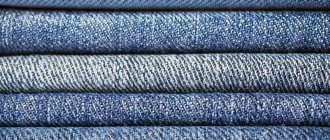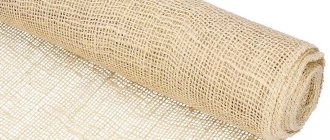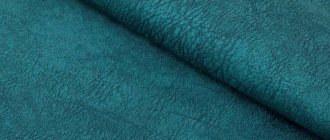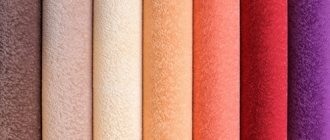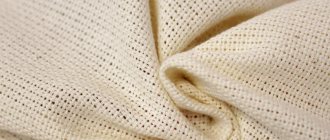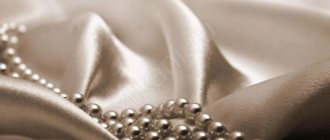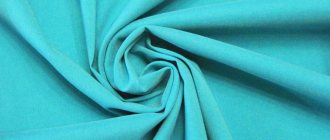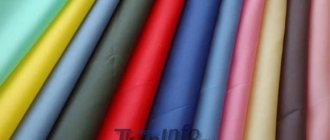Density and types of denim fabric
It’s no secret that they are made from denim, the so-called “jeans”. But not everyone knows how this fabric is made and what types it comes in. We will not delve into all the complexities of the technological process - there is no such need for us, lovers of denim clothing, but understanding some of the subtleties is still very useful.
Denim is high density cotton. Traditionally, the fabric is dyed a rich indigo blue, but modern denim comes in a wide variety of colors and shades. There are several types of denim depending on the production technology and dyeing method:
Denim
Classic denim is the most common and most expensive type of denim material. Denim is distinguished by a characteristic interweaving of two cotton threads: dyed and undyed. The distinctive effect of the appearance of the fabric is achieved thanks to the microscopic white pile. The fabric has a one-sided color on the front side, the back side always remains white.
Serge (Broken twill)
Broken twill has an easily recognizable characteristic herringbone weave. Depending on the direction of the twill lines, the relief and density of the fabric changes. This type of jeans was first used by Wrangler in the 13MWZ model in 1964. And it remains unchanged to its traditions to this day: almost everything is made from broken twill.
Stretch
This fabric is also known by another name: lycra (jeans with lycra). Lycra is the name of a French company that pioneered the production of stretch denim. The fabric contains elastane, which is known for its stretchy effect. Thanks to this, the jeans fit tightly and emphasize the figure.
One of the most inexpensive types of denim. Gin is produced in Genoa, hence the name of the material - a distortion of the name of the area. The fabric has a characteristic monochromatic color. Gin does not differ in the quality of cotton and is a low-quality material. But it attracts with its price. Well-known world brands do not use this type of jeans.
Chambray
Chambry is a type of denim that is distinguished by its particularly thin and light material. The fabric density is 4-7 oz/sq. yard, compared to classic denim at 14.5 oz/sq. yard. This type of fabric is used for sewing summer and light clothing (shirts, sundresses, underwear, etc.)
Ecru
Translated, “ecru” means “unbleached.” The peculiarity of the fabric is that it is not dyed, but has a natural cotton color.
It should be noted that the quality of denim directly depends on the quality of the cotton from which it is made. There are several types of raw materials for the production of denim material:
Mexican cotton - a 24 cm long fiber allows you to produce quality denim that is smooth and without scars.
Barbados cotton is one of the highest quality raw materials. Cotton is soft, durable and has a characteristic shine. The process of growing and harvesting cotton requires special conditions and is a rather complex process, which is reflected in its price. On the global market, only 7% of denim products are made from Barbadian cotton.
Zimbabwean cotton is a material of high quality and at the same time low price. The low cost of raw materials is due to the fact that this cotton is not included in the world cotton classification.
Asian and Indian cotton are the most used and common type of cotton. Half of the world's denim products are made from this raw material. Indian cotton fiber has a short-staple structure (long-length fiber).
Recently, well-known world manufacturers of denim clothing have also been using an alternative material made from cellulose fiber, known as Tencel. Cellulose fiber, made from wood, is spun into threads that are made into fabric. The material has excellent performance characteristics and is in great demand. Tencel has a velvety texture, which makes it pleasant to the body and to the touch. The fabric is light, soft and very durable. For example, Tencel is several times stronger than viscose. This material can be painted easily and with high quality. The paint lasts long enough and is resistant to repeated washing. A big advantage of Tencel is its high degree of hygroscopicity. The material perfectly absorbs moisture and removes it well. Thanks to these properties, these jeans are not cold in winter and not hot in summer.
Depending on the type of fabric from which the jeans are made, manufacturers indicate characteristic inscriptions on the tags. When choosing jeans, be sure to pay attention to the following symbols, this will help you choose the right trouser size:
· Preshrunk (pre-shrinkage) – this inscription indicates that after the first wash the jeans will not shrink, because the fabric was subjected to preliminary shrinkage (permissible shrinkage is possible - 3%);
· Shrunk-to-fit (without preliminary shrinkage) – jeans will shrink by 10-12% after washing;
· Prewashed (Washable, One washed) – the product does not fade or be wiped off, because the preliminary fabric processing process involves washing;
· Rigid (Unwashed) (without pre-washing) – jeans made of very dense, rigid fabric that can fade. Jeans become softer after several washes.
Denim Density
Denim also comes in different thicknesses. Depending on the density of the fabric, denim products have a conditional seasonal division: spring-summer and autumn-winter.
The density of jeans is measured in ounces per square yard (1 yard = 0.9144 m = 91.44 cm; 1 ounce = 28.349523125 g). In other words, a piece of fabric 1 yard long and 28.5 inches wide (1 inch = 2.54 cm) weighs 14.5 ounces or 411 grams. The total weight of the jeans is 800 grams.
Regular classic denim weighs 13-14.5 ounces per square yard, while heavyweight denim can weigh anywhere from 15.5 ounces per square yard. yard and above. Lightweight denim weighs 10-13 oz/sq. yard, and the thinnest (gabardine fabric) - 4-9 ounces/sq. yard.
For winter garments, thicker denim is accordingly used, typically 14.5 oz/sq. yard. For convenience, in the online store “site” we have conditionally divided the density of denim from 1 to 5, where 1 is the thinnest denim (4-9 ounces/sq. yard), and 5 is the densest (14.5 - 15 .5 oz/sq yd).
That’s actually all the main basics on the types and densities of denim fabrics. If you have any questions, our specialists are always happy to help you.
Buying jeans in the online store "" is always easy, fast and convenient! We can see this for ourselves!
How to convert ounces to grams? In order to learn how to convert these quantities, first of all, it is necessary to say what this very ounce is.
The word ounce, or “uncia,” takes its name from ancient Rome. In turn, an ounce, in the concept of the ancient Romans, was 1/12 of a large bronze coin weighing 27.288 grams, or one tenth depending on the time.
Since the 13th century, 1 ounce has been equal to 1/16 of a pound. Needless to say, the modern ounce differs significantly in weight from the ancient Roman one.
Over the years, this measure of weight was used throughout Europe, and in the modern world it is widely used in banking, pharmaceuticals and jewelry. Therefore, the need to convert ounces to grams arose there.
As a rule, when people talk about gold, they most often mean the troy ounce.
Convert oz to grams
It is worth noting that the ounce has the international designation oz. 1 ounce is currently 28.349523 grams. The value of this value changes twice a day and depends on the London fixing rate.
Of course, in the modern world there are a huge number of currency converters that can easily help you convert one value into another. We are pursuing another goal - to learn how to independently convert these values. This way we can find out how many grams an ounce is.
The formula for calculation will be as follows: (? oz) * (1 lb/16 oz) * (1 kg / 2.2046 lb) * (1000 g / 1 kg) =
To calculate how many grams are in ounces, you need to substitute the value you are interested in. So, 1 ounce in grams will be:
1oz * (1lb/16 oz) * (1 kg/2.2046 lb) * (1000g/1 kg) = 28.349814g
Four ounces:
4oz * (1lb/16 oz) * (1 kg/2.2046 lb) * (1000g/1 kg) =113.396041g
5 oz:
5oz * (1lb/16 oz) * (1 kg/2.2046 lb) * (1000g/1 kg) =141.749070g
9 oz:
9oz * (1lb/16 oz) * (1 kg/2.2046 lb) * (1000g/1 kg) =255.148326g
This method is one of the most accurate; it will easily help you find out how many grams are contained in a particular quantity of oz, thereby showing the weight of an ounce.
In addition to this method, the table will help you find out how much one tenth or more of an ounce contains:
| oz | gr. | oz | gr. | oz | gr. | oz | gr. | oz | gr. | oz | gr. | oz | gr. | oz | gr. | oz | gr. |
| 1/2 | 14.18 | 2/3 | 18.99 | 3/4 | 21.26 | 4/5 | 22.68 | 5/6 | 23.53 | 6/7 | 24.38 | 7/8 | 24.95 | 8/9 | 25.3 | 9/10 | 25.52 |
| 1/3 | 9.44 | 2/5 | 11.34 | 3/5 | 17.01 | 4/7 | 16.16 | 5/7 | 20.13 | 6/11 | 15.46 | 7/9 | 22.11 | 8/11 | 20.62 | 9/11 | 23.2 |
| 1/4 | 7.09 | 2/7 | 8.22 | 3/7 | 12.19 | 4/9 | 12.47 | 5/8 | 17.86 | 6/13 | 13.08 | 7/10 | 19.85 | 8/13 | 17.45 | 9/13 | 19.63 |
| 1/5 | 5.67 | 2/9 | 6.24 | 3/8 | 10.77 | 4/11 | 10.31 | 5/9 | 15.88 | 6/16 | 10.63 | 7/11 | 18.04 | 8/15 | 15.12 | 9/14 | 18.23 |
| 1/6 | 4.82 | 2/11 | 5.15 | 3/10 | 8.51 | 4/13 | 8.72 | 5/11 | 12.89 | 6/17 | 10 | 7/12 | 16.54 | 8/17 | 13.34 | 9/17 | 15.95 |
| 1/7 | 3.97 | 2/13 | 4.36 | 3/11 | 7.73 | 4/14 | 8.1 | 5/12 | 11.81 | 6/19 | 8.95 | 7/13 | 15.27 | 8/19 | 11.94 | 9/20 | 15.01 |
| 1/8 | 3.69 | 2/15 | 3.78 | 3/13 | 6.54 | 4/15 | 7.56 | 5/13 | 10.9 | 6/25 | 6.8 | 7/15 | 13.23 | 8/21 | 10.8 | 9/25 | 12.76 |
| 1/9 | 3.12 | 2/17 | 3.34 | 3/14 | 6.08 | 4/17 | 6.67 | 5/14 | 10.12 | 6/35 | 4.86 | 7/16 | 12.4 | 8/25 | 9.07 | 9/35 | 10.21 |
| 1/10 | 2.83 | 2/19 | 2.98 | 3/16 | 5.32 | 4/18 | 6.3 | 5/21 | 6.75 | 6/45 | 3.78 | 7/17 | 11.67 | 8/31 | 7.32 | 9/40 | 7.29 |
| 1/11 | 2.58 | 2/21 | 2.7 | 3/17 | 5 | 4/19 | 5.97 | 5/31 | 4.57 | 6/55 | 3.09 | 7/18 | 11.03 | 8/41 | 5.53 | 9/50 | 6.38 |
| 1/12 | 2.36 | 2/25 | 2.27 | 3/19 | 4.48 | 4/21 | 5.4 | 5/41 | 3.46 | 6/65 | 2.61 | 7/19 | 10.45 | 8/51 | 4.45 | 9/60 | 5.1 |
| 1/13 | 2.18 | 2/31 | 1.83 | 3/20 | 4.25 | 4/25 | 4.54 | 5/51 | 2.78 | 6/75 | 2.27 | 7/20 | 9.92 | 8/61 | 3.72 | 9/70 | 4.25 |
| 1/14 | 2.03 | 2/41 | 1.38 | 3/25 | 3.4 | 4/35 | 3.24 | 5/61 | 2.32 | 6/85 | 2 | 7/25 | 7.94 | 8/71 | 3.19 | 9/80 | 3.65 |
| 1/15 | 1.89 | 2/51 | 1.11 | 3/35 | 2.43 | 4/45 | 2.52 | 5/71 | 2 | 6/95 | 1.79 | 7/30 | 6.62 | 8/81 | 2.8 | 9/90 | 3.19 |
| 1/16 | 1.77 | 2/61 | 0.93 | 3/40 | 2.13 | 4/55 | 2.06 | 5/81 | 1.75 | 7/40 | 4.96 | 8/91 | 2.49 | 9/100 | 2.55 | ||
| 1/17 | 1.67 | 2/71 | 0.8 | 3/50 | 1.7 | 4/65 | 1.75 | 5/91 | 1.56 | 7/50 | 3.97 | ||||||
| 1/18 | 1.58 | 2/81 | 0.7 | 3/70 | 1.22 | 4/75 | 1.51 | 7/60 | 3.31 | ||||||||
| 1/19 | 1.49 | 2/91 | 0.62 | 3/80 | 1.06 | 4/85 | 1.33 | 7/80 | 2.48 | ||||||||
| 1/20 | 1.42 | 2/99 | 0.57 | 3/100 | 0.85 | 4/95 | 1.19 | 7/90 | 2.21 | ||||||||
| 1/25 | 1.13 | 7/100 | 1.98 | ||||||||||||||
| 1/30 | 0.95 | ||||||||||||||||
| 1/40 | 0.71 | ||||||||||||||||
| 1/50 | 0.57 | ||||||||||||||||
| 1/60 | 0.47 | ||||||||||||||||
| 1/70 | 0.41 | ||||||||||||||||
| 1/80 | 0.35 | ||||||||||||||||
| 1/90 | 0.32 | ||||||||||||||||
| 1/100 | 0.28 |
- Few people know that in addition to a measure of weight, 1 ounce can be represented as a measure of liquid volume, or 1 fl oz, so 1 ounce in grams will be equivalent to 30 ml of liquid.
- Freely convertible currencies currently account for 15% of the entire financial market;
- 1 pharmacy ounce is 29.860 grams. This value was widespread until 1930, then lost its validity;
- Not every person knows about Maria Theresa's ounce, which was 31.1025 grams. This coin was forged many times, and finally, for the tenth time, it came out the way the queen wanted.
Especially for you, we have compiled a short but comprehensive guide, after reading which you can casually say to the charming consultant: “You know, I prefer 12-ounce stone-washed, although I will not refuse raw denim.” If after this there is no piece of paper with her phone number in the pocket of your newly purchased pants, then you will, in any case, become the owner of a good pair of jeans.
Name
Although we strongly associate jeans with the Wild West, cowboys and the ability to open the door to a saloon with your feet, the word itself is not American, but Italian in origin. Already in the 17th century, the townswomen of Genoa walked around in sundresses made of thick twill, and artists painted sketches in shabby blue jackets with raised collars.
Maestro della tela jeans, “Beggar boy with a piece of pie” (late 17th century)
In the next century, the denim boom reached the south of France, and especially the city of Nîmes, where twill began to be produced in such quantities that soon all such fabric began to be called simply “from Nîmes” (de Nîmes). The Americans, far from the grammatical subtleties of the French language, turned the preposition and the name of the city into one word and began to simply call such fabric denim. And the pants, made from denim, became jeans in honor of Genoa, called Gênes in French.
Popular types of denim
Denim products can be divided into several groups according to the following criteria: dyeing technique, weaving method and fabric composition.
Chambray
The lightest denim. It is not inferior in strength to denser types. Consists of thin threads of various shades of blue, gray, brown and purple. Very soft and tactilely pleasant material. Most often, dresses, shirts and sundresses are made from it.
Stretch
It differs from the previous one in the presence of elastane fiber in its composition. The more it is in the material, the better it stretches. Stretch items are elastic and tight-fitting. The fabric is easily deformed and returns to its original shape. Most often, trousers and skirts are made from it.
Gin
Cotton fabric with the addition of cellulose with a diagonal weave. It is cheaper than other types of denim. On it you will not find the generally accepted twisting of threads, so the material is incredibly durable. The color is distributed evenly over the entire area of the fabric. Most often, jeans and denim jackets are made from it.
Cowboys, miners and a couple of emigrants
In America, jeans have long been the favorite clothing of ordinary workers. Pants, in which one could sort through ore in search of gold bars or ride around wild herds without fear of holes, enjoyed deserved popularity. But the weight of the tools often tore the pockets off my jeans. This problem was solved by Latvian emigrant Jacob Davis, who came up with the idea of attaching pockets to jeans with metal rivets. Davis did not have the money to patent his idea, so he entered into a share with Levi Strauss. A year after the patent, Levi's sold more than twenty thousand pants and jackets. The appearance of the “fifth” small pocket, located inside the right front pocket, dates back to the era of the gold rush - prospectors put the nuggets they found in it, and the wealthiest kept watches in it. However, it is also great for other things, as Michel Gondry showed in his Levi’s ad.
Denim - the material from which, as you remember, jeans are made - varies in processing and density. Denim that has never been washed before being sold is called untreated or raw. Jeans made from raw denim are distinguished by a uniform dark blue color, which, like especially gifted children, is also called indigo. The advantage of these jeans lies in their durability, and also in the fact that after each wash they shrink and fade depending on how they were worn. It is better to wash them no more than once a month, because each wash changes their appearance so that after several washes, the jeans end up with a unique pattern of creases and abrasions.
Most jeans, however, are washed before they are put up for sale, and the imagination of manufacturers is not limited to selecting the right powder and gentle softener. In pursuit of interesting patterns, they resort to all sorts of tricks, for example, putting pebbles in the drum of a washing machine and giving jeans that have survived a collision with stones the proud name stone washed. The British brand All Saints even documented this process.
When choosing jeans, you should pay attention to their density, which is traditionally measured in ounces (Oz). Lightweight jeans suitable for warm weather should be no thicker than 12-13 ounces. Denim that weighs 15 ounces or more is typically called heavy denim. It is very durable, but can be difficult to wear through multiple washes due to its stiffness. Jeans that weigh more than 20 ounces are not for everyone. But they can be placed somewhere and forgotten - they will maintain a vertical position even without their owner inside.
How denim is made
The fabric is sewn according to the principle of twill weave: the warp thread dives under every third weft thread. Its distinctive feature is the blue color characteristic of denim products. To obtain black color, manufacturers used sulfur-based dyes. The reverse side of the canvas is always white. Lycra or elastane is usually added to it to increase strength and resistance to wear.
Types of denim weave:
- Right
- the diagonal of the picture is directed from the lower left to the upper right corner. The so-called classic denim. - Left
- with this weave, the denim fabric turns out softer and smoother. - Herringbone
- the surface of the material is similar to zigzags. As with the left weave, the material becomes smoother.
Denim is based on cotton. Most often, high-quality denim products are made from raw materials grown in the USA, Egypt and Mexico (Gossypium barbadense, Upland cotton, Extra Long Staple). The fiber length of this cotton varies from 2.5 cm to 7 cm. Cheaper cotton is obtained in Asia, India and Zimbabwe.
Interesting facts about denim production:
- Products made from high-quality denim must be rolled between two very hot rollers. This is how the manufacturer prevents items from shrinking too much after washing.
- Manufacturers of cheap cotton clothing add cellulose fibers to increase the wear resistance of the material.
- The color intensity of the material directly depends on the number of dips in the bowl with dye and subsequent drying.
The main thing is that the jeans fit
The number of ways to cut and name a pair of pants exceeds any decent size. But the main thing is to remember the three main names: skinny, slim and regular. Ultra-tight skinny jeans look good on fifteen-year-old skaters and no one else. Even Levi's designers realize this, and it is no coincidence that they named their model of skinny jeans - your ex-girlfriend's jeans. If you want the girl to stay with you, we advise you to refrain from them.
Many men are somewhat distrustful of the slim style, which is not tight, but tapers at the bottom. But in vain! These jeans slim their wearers and also go well with coats, jackets, cardigans and fitted shirts - in fact, with almost all formal wear. Regular is a fairly wide straight cut pair of jeans. They are best combined with T-shirts, windbreakers and flannel shirts.
When purchasing jeans, it is also important to pay attention to the fit. Jeans should not bulge at the knees or be too long. If you have to tuck them more than once, it is better to hem them. The waistline should be slightly higher than the hips, so that when you bend over, your underwear is not exposed to the whole world. This fit also visually lengthens your legs, so that your figure becomes similar to the silhouette of Leonardo’s ideal man.
If you're tired of Levi's
Three alternatives to the main American jeans.
Edwin
Great Japanese brand. The Japanese are known for their meticulous attention to detail and obsession with quality. Thanks to this, the pair you buy will not only look great, but will also last you longer than jeans from other brands. An excellent all-around model is the ED-71 Slim Unwashed.
Uniqlo
Also a Japanese, but more affordable brand that makes inexpensive jeans. Uniqlo jeans are made from very lightweight denim, making them easy and comfortable to wear. You have to pay for this with fragility - such jeans are unlikely to survive more than a couple of seasons.
APC
A French brand that makes laconic and good things. The brand's form-fitting jeans are distinguished by elegant simplicity. Besides, they are not made in China. So if the thought of Chinese children poring over your jeans for 12 hours straight makes you wake up in a cold sweat, this is the right choice.
Many of you, of course, have heard the word “ounce”. But does everyone know what it means? It's outdated and more. By the way, this concept has a rich history. And in some sectors of the economy you can’t do without it. So 1 ounce how many grams weighs?
How to care for denim
At the end of the last century, denim was washed in cold water, and laundry soap was used as a powder. Thanks to this, the material retained its original shape. In 2021, you can simply throw this material into the washing machine, following some rules:
- Separate from other clothing.
- At a temperature of no more than 40 °C in gentle mode.
- Spin at low speed.
- Turn the product inside out before washing, fasten the zippers and buttons.
- Do not use bleaches or chemically aggressive substances.
When washing by hand, it is not recommended to listen to the product by twisting it. It is better to let the product dry on its own. And when it is slightly damp, stretch it to the desired shape. Ironing is also recommended at low temperatures.
Word
Without a doubt, this is a term of Latin origin. In ancient Rome, this was the name given to one twelfth of the libra, the basic measure of weight. However, not only mass was measured with it. In general, it may seem that the Romans were very fond of this word.
They often said: “I walked four ounces of the way to...” or “I read three ounces of the book.” What did this mean? Is it really possible to measure distance using scales? Of course not. An ounce is another twelfth of something. Well, either one tenth or thirteenth - depending on the country and time. So what else was measured for her? And How? Also in Ancient Rome, an ounce was called a coin. When minting, one dot was placed on it. The coin, of course, had a small denomination. It was made from an alloy of tin, copper and lead. Some Spanish (doubloons) and Chinese gold coins were also called this way.
Fabric composition and its properties
Jeans are made from cotton. It may also contain synthetic threads. Often these are elastane and viscose. Such inclusions help make the fabric less rough and more elastic, which makes it comfortable to wear. Synthetic threads allow things to fit beautifully.
Cotton
What are the properties of cotton or cotton fabric? What are its areas of application?
more details
A characteristic feature of the fabric is a relief in the form of an oblique hem. The ratio of cotton and synthetic fibers, as well as the density of the weaving of the threads, determines how strongly the texture will be expressed.
Troy ounce
Probably the most can be said about this unit of measurement. Currently it is used for weighing precious metals. It is also a unit when trading the latter on special exchanges.
There, prices for gold and other precious metals are determined precisely on the basis of one troy ounce. Its weight in metric terms is approximately 31.103 grams. As you can see, it is different from a regular ounce. It is also used in jewelry and banking. It is also used to measure the weight of valuable ingredients in cosmetology. But how did it come about?
The origin of this term can be dated back to the thirteenth century AD. Some may find it surprising, but this measure has nothing to do with the legendary city of Troy. And she appeared in the French city of Troyes. There, at that time (12-13 centuries, and according to some sources - from the 5th century), three-month fairs became very popular, attracting people from many European countries. The abundance of different currencies (in France at that time almost every city had its own money) and weights (each product had its own) created confusion in trade, and therefore after some time it was decided to take the French livre, which contained a pound of silver, as the standard.
1 troy ounce, respectively, is one twelfth of this weight measure. There is an opinion that this could not have happened without the participation of the French crown. In any case, the unit seemed very convenient. After all, this coin weighed exactly a pound. And at that time, money was valued precisely for its weight. It was later that the precious metal in them began to be replaced with nickel or copper. However, kings came and went. And control over the minters, of whom there were quite a lot, was not always at a sufficient level. So silver became less and less. Very often, precious coins were cut off altogether in order to extract silver or gold. Therefore, it was necessary to introduce standard coinage with a clear boundary. Over time, gold and silver, of course, have significantly increased in value and the value of all world coins. And they practically stopped adding them there.
Coins
Currently, banks in many countries around the world continue to issue gold coins. Moreover, they are purchased not only for private collections. This way people can invest and store money in gold. In this sense, it is equivalent to gold bars. Most of these coins contain just a troy ounce of gold:
1. Australian gold bar (coin).
2. Austrian Philharmonic.
3. American golden buffalo.
5. Canadian golden maple leaf.
6. Chinese panda.
7. South African Krugerrand.
They all have the corresponding inscription. Moreover, of course, not all of them weigh exactly a troy ounce. They may also contain other metals. But a troy ounce of gold, silver or platinum must be in them. By the way, when buying precious metals online, be careful: in what units of measurement the weight is indicated. After all, an ounce of avoirdupois (it is now most often used in trade) is lighter than a troy ounce. As you can see, this seemingly outdated measure of weight has no intention of losing its position in this area to grams and kilograms. Perhaps this is because such a significant commodity as gold, for example, must also be measured in significant quantities. And it’s easier to produce ingots weighing 31 g than one-gram ones. In general, using the example of a coin, you can perfectly and easily answer the question: “An ounce is how many grams of gold?”
American system of measures
In the United States, pounds are still used to measure weight. And along with them, therefore, ounces. But again, not the same as everywhere else.
Avoirdupois or the so-called trading ounce. Used for selling goods by weight. In the metric system its value is 28.349 g.
The US fluid ounce is used to measure volumes. It is approximately 29.537 ml. When indicating the volume on food packages, for convenience, it is equated to 30 milliliters. The British, by the way, have their own fluid ounce. Its volume is 28.413 ml.
What type of fabric is this?
In its pure form, denim is tough and dense. Now it is produced almost all over the world. The standard weave is twill with a slant from right to left.
Jeans colors
On the front side the fibers are painted. It is the main side of the canvas. The reverse side is represented by unpainted ducks. Coloring can be done either with natural dyes (indigo) using the boiling method, or with the use of artificial additives.
European weights
Like many other things, the ounce was borrowed from the Roman Empire by almost all the peoples of Europe. And it was used everywhere until the introduction of the metric system in the eighteenth century. So, for example, in Germany it was considered one sixteenth of a trade pound. It was also used in medicine, where it was equal to 1/12 of the small pharmaceutical weight. It was used to measure weight when preparing medicines. The so-called apothecary ounce has survived to this day. Russia also adopted this system from the Germans. It weighed from 25 to 35 g, depending on the country where it was used. It is sometimes used today. Therefore, when buying any foreign medicine at a pharmacy, it is important to know how many grams are in 1 ounce. Neither you nor the doctor need an overdose.
In the Netherlands they also used the ounce. And even when they switched to a new system in 1820, they retained their Dutch ounce to indicate its weight of one hundred grams.
Other European countries were not far behind. In Italy there were 12 Roman ounces in the pound, and in Spain and Portugal there were 16 in the Castilian libre and artel respectively.
In England, there were the above-mentioned troy ounce, apothecary and commercial. They were fractions of pounds of the same name. But if troy and apothecary are 1/12, then a trade ounce was equal to one sixteenth.
And once again about coins. In Sicily, until 1860, the ounce was in use. It was equal to two and a half scudi, three ducats. And it was equivalent to one hundred and twenty-three Italian lire of modern times.
